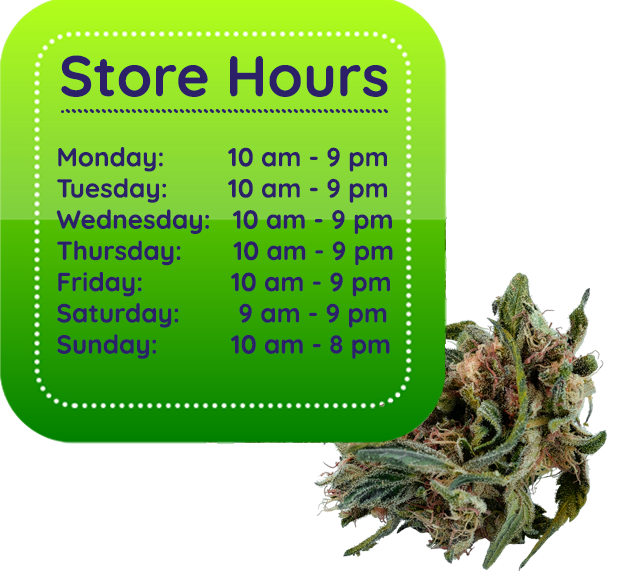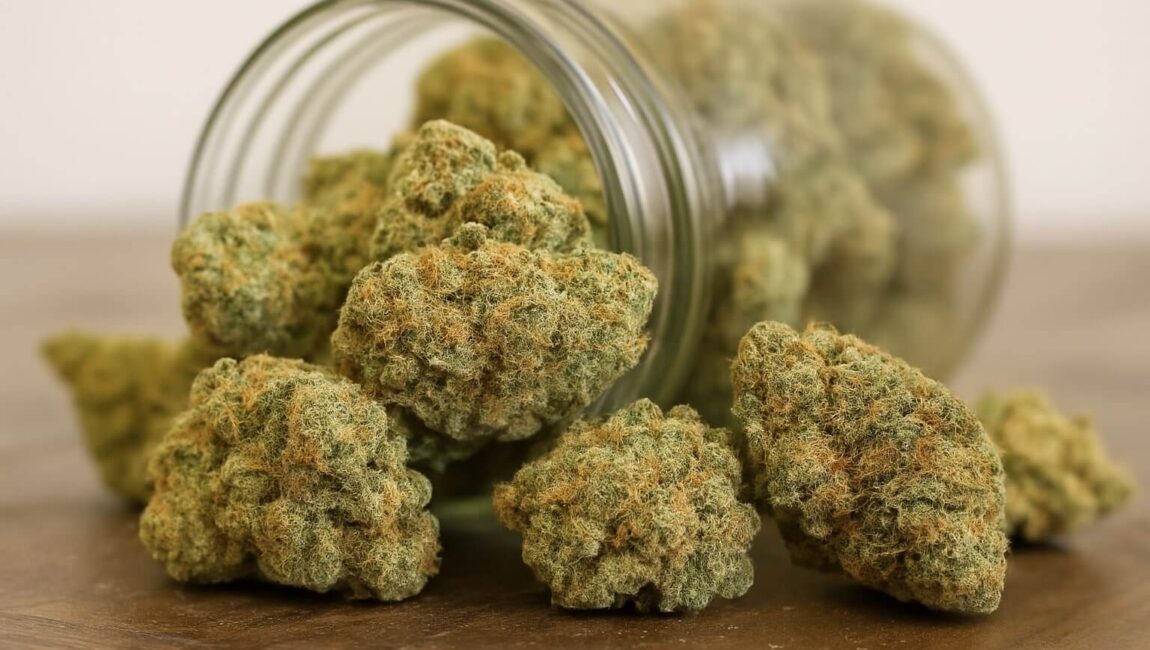
Does Weed Go Bad?
Yes, weed goes bad over time due to THC degradation, loss of terpenes, and potential mold growth when stored improperly.
THC converts into the less psychoactive cannabinoid CBN, reducing potency. Exposure to air, light, heat, and humidity also breaks down flavor and aroma. Mold makes old cannabis unsafe to inhale.
Do Weed Pens Expire?
Yes, weed pens typically expire within 6 to 12 months as the oil degrades and the battery loses charge.
Exposure to heat or oxygen can cause oil crystallization, clogs, or leaks. Storing them upright in a cool, dark place helps preserve both the cartridge and the vape hardware.
What Happens If You Eat Expired Edible Gummies?
Eating expired edible gummies usually isn’t dangerous, but effects may be weaker. THC and CBD degrade over time, reducing potency. Taste and texture can change, and expired gummies may grow mold or bacteria, which can cause food poisoning. If gummies smell off or appear discolored, they should be thrown away.
How Long Can You Store THC Gummies?
THC gummies last 6 to 12 months when stored in a cool, dry place away from light and moisture.
Though cannabinoids are stable, gummies are food products that can spoil, especially in humid climates. Always check the expiration date and avoid gummies with visible changes in texture, color, or smell.
Does THC Oil Go Bad?
Yes, THC oil can go bad after 1 to 2 years due to oxidation and terpene breakdown.
Signs of degradation include darker color, bitter taste, or separation. Storing THC oil in airtight, UV-protected containers at stable room temperatures slows cannabinoid loss and preserves effectiveness.
Table of Contents
Does weed go bad?
Does weed go bad? Not in the traditional sense like food products. Instead, cannabis gradually degrades due to light exposure, air exposure, humidity, and extreme temperatures. This affects its terpene retention, aroma, flavor of cannabis, and psychoactive effects.
Cannabis only becomes truly unsafe when it develops mold spores, resulting in potential health concerns such as respiratory issues. Otherwise, cannabis may be stale but not harmful — unless it lacks all freshness indicators like scent, color, and stickiness.
When stored properly, cannabis can remain viable for up to two years, though potency over time declines. Terms like stale, aged weed, or degraded better describe old cannabis than “expired.”
What makes weed go bad?
Cannabis quality and shelf life are significantly impacted by several key factors, including environmental conditions and initial cannabis quality. Understanding these factors helps ensure optimal preservation and potency.
Influence of Initial Cannabis Quality
Proper harvesting, drying, and curing practices critically determine the longevity of cannabis:
-
Harvest Timing: Cannabis should be harvested at peak ripeness to maximize cannabinoid stability and terpene production, directly affecting potency and therapeutic effects.
-
Drying Process: Properly dried cannabis should not become overly dry or brittle, as excessively dry buds lose potency, flavor, and result in harsh smoke.
-
Curing Process: Effective curing ensures even moisture distribution and chlorophyll breakdown, which enhances freshness, aroma, smoothness during consumption, and overall storage longevity.
Poor initial cannabis quality, resulting from improper harvesting, drying, or curing, accelerates degradation, diminishing the product’s shelf life significantly.
Genetic Factors and Cannabis Stability
The genetic makeup of cannabis influences traits like terpene content and cannabinoid profiles, which may affect how a strain resists degradation over time. While research into the genetic basis of shelf stability is still emerging, some strains bred for resin density and mold resistance may retain their potency and freshness longer when stored under proper conditions [Genetic Stability in Cannabis Plants].:
-
Terpene Profiles: Some terpenes — including limonene, pinene, and linalool — show antimicrobial and antioxidant properties in lab studies [Antimicrobial Activity of Terpenes].. While this suggests potential protective effects against mold or oxidation, these benefits vary by strain, concentration, and storage environment, and should not be relied upon as a substitute for proper storage techniques [Cannabis Resins and Terpene Antioxidant Effects].
-
Oxidative Stress Resistance: Certain cannabis strains exhibit superior resistance to oxidative stress, helping them retain potency and freshness longer.
-
Breeding Practices: Cannabis breeders intentionally select strains for enhanced mold resistance, therapeutic potency, and long-lasting freshness, thus improving overall cannabis preservation.
Choosing cannabis strains known for resilient terpene profiles, oxidative resistance, and excellent shelf stability significantly enhances your cannabis experience by preserving potency, aroma, and effectiveness over extended periods.
How Can I Tell If My Weed Went Bad
What Does Bad Weed Look Like?
-
Smell: Faint or grassy, lacking usual cannabis smell.
-
Color: Fades from vibrant greens to yellows or browns.
-
Texture: Crumbles easily; brittle texture signals aging.
-
Trichomes: Once shiny, may appear dull or amber.
-
Taste: Lacks flavor, may feel harsh or dusty.
Detecting Mold in Weed:
-
Visual: Fuzzy, powdery, cobweb-like, or cottony growth—white, gray, black, or yellow.
-
Smell: Musty, damp, ammonia-like, or hay odor.
-
Texture: Slimy, damp, or unusually spongy.
-
Tools: Use a jeweler’s loupe to detect mold vs. trichomes.
Immediately discard cannabis showing mold indicators to prevent health risks such as respiratory issues and lung infections.
How THC and Terpenes Degrade During Storage
Cannabis degradation involves several chemical changes:
-
Cannabinoid Degradation (THC → CBN): Oxidation transforms psychoactive THC into the less potent CBN [THC Degradation into CBN Explained].
-
Decarboxylation (THCA → THC): Occurs gradually, converting non-psychoactive THCA into THC.
-
Terpene Evaporation: Aromatic terpenes degrade, reducing the flavor profile and therapeutic benefits [How Terpenes Degrade Over Time].
Understanding these processes helps in preserving weed effectively.
What Happens if I Smoke Old weed?

How Smoking Old Cannabis Affects Potency and Experience
Consuming old cannabis primarily poses quality-related issues:
-
Reduced Potency: THC degrades into CBN, significantly lowering psychoactive effects and therapeutic benefits.
-
Increased Sedation: Higher CBN content often results in more pronounced sedation or drowsiness.
-
Harsher Smoke: Overly dry cannabis creates harsher, irritating smoke or vapor, potentially causing throat discomfort and irritation.
Why Moldy Cannabis Is Unsafe to Smoke
Moldy cannabis presents severe health risks, especially when inhaled:
-
General Risks: Mold inhalation can trigger coughing, wheezing, sinus issues, allergic reactions, nausea, and vomiting.
-
High-Risk Individuals:Certain groups are especially vulnerable to severe outcomes from smoking mold-contaminated cannabis, including:
-
Immune-compromised Users: Individuals undergoing chemotherapy, organ transplants, or those with HIV/AIDS face potentially life-threatening lung infections from mold exposure.
-
Chronic Respiratory Conditions: Individuals with asthma, chronic obstructive pulmonary disease (COPD), or similar conditions can experience severe respiratory distress upon inhaling mold spores.
-
Mold Allergies: People with mold allergies may experience intensified allergic reactions, including respiratory inflammation.
-
Always carefully inspect cannabis before consumption, discarding immediately if any signs of mold or contamination are present.
What Happens if I consume Expired THC Edibles and Gummies
Spoiled or improperly stored edibles can lead to foodborne illnesses due to mold or bacterial growth. Always observe expiration dates and inspect packaging integrity, and consider choosing premium cannabis gummies from trusted dispensaries to ensure safety and quality.
What Happens if I consume Expired THC Oils (Extracts) and Tinctures
Oils can degrade, crystallize, or become contaminated, potentially reducing therapeutic effectiveness and increasing health risks. To get the most out of your experience, consider premium cannabis extracts crafted for purity, potency, and long-term stability.
What Happens if I consume Expired Vape Products
Mold or bacterial contamination in vape cartridges can cause severe respiratory issues. Leaky or degraded vape oils can lead to clogged hardware, poor performance, and health hazards. To reduce the risks of poor-quality products, invest in reliable cannabis vape carts that meet safety standards.
Maintaining optimal storage and regularly checking the quality and integrity of cannabis products help mitigate these risks and ensure safe, enjoyable consumption.
But how exactly should you store your weed to keep it in top shape?
Let’s walk through the most effective ways to preserve freshness, potency, and safety—whether you’re saving flower for later or protecting your investment in edibles, oils, or pens
How to keep Weed Fresh Longer
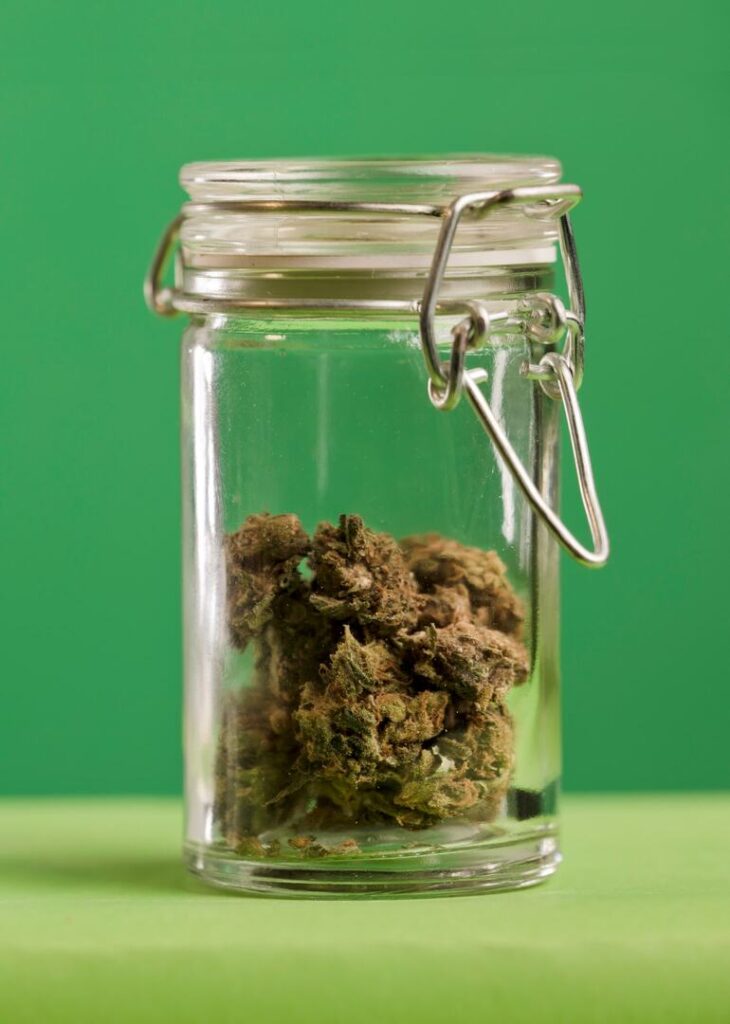
Environmental Recommendations
-
Temperature: Store between 60–70°F (15–21°C), avoiding extreme temperatures.
-
Humidity: Maintain relative humidity between 59–63% using humidity packs.
-
Light: Avoid UV exposure; store in dark spaces or opaque jars.
-
Air: Minimize air exposure using true airtight containers.
Best Storage Methods for Cannabis
Proper storage significantly influences cannabis potency, freshness, and overall shelf life. Utilizing the right storage containers and methods helps maintain ideal conditions to preserve cannabis effectively.
Recommended Storage Containers
-
Airtight Glass Jars (Mason Jars): These are the optimal choice for cannabis storage, effectively preserving terpene profiles, aroma, and potency. Preferably use opaque jars or keep clear jars in dark areas to protect cannabis from harmful UV exposure.
-
Vacuum Sealing: Suitable for long-term cannabis storage, vacuum sealing effectively minimizes oxygen exposure and cannabinoid oxidation. However, this method can compress and flatten delicate buds, affecting appearance.
-
Specialized Cannabis Humidors: Specifically designed for cannabis storage, these humidors precisely regulate relative humidity (RH) levels, maintaining ideal moisture (59-63%) to prevent dryness and mold growth.
Humidity Management
-
Humidity Packs: Essential for maintaining optimal moisture levels inside airtight containers, humidity packs stabilize RH around 59-63%, protecting cannabis from excessive dryness or mold formation.
Storage Methods to Avoid

-
Plastic Bags (e.g., Ziploc): Avoid due to poor airtightness, air circulation issues, static charges damaging trichomes, and potential chemical interactions.
-
Refrigeration and Freezing: These methods cause condensation, trichome brittleness, and overall cannabinoid degradation, severely harming cannabis potency and structural integrity.
Using proper cannabis storage methods and containers significantly enhances your cannabis experience by preserving potency, freshness, and therapeutic benefits over extended periods.
Frequently Asked Questions
Does weed go bad over time?
Yes. While cannabis doesn’t “expire” like food, it does degrade. Weed gets old and loses potency, aroma, and flavor due to exposure to air, moisture, heat, and light. Over time, THC converts to less active compounds, which reduces its effects.
How long does weed last in proper storage?
When stored correctly—airtight jars, 60–70°F, 59–63% humidity—weed can last 6 months to 2 years. After that, potency declines. Using cannabis storage jars with humidity packs is the best way to keep weed fresh.
Can weed get moldy?
Yes. Weed stored in overly humid or damp conditions may develop mold, which looks fuzzy or powdery and smells musty. Moldy cannabis should never be consumed, as it poses serious health risks.
What does bad weed look like?
Bad weed may appear dry, brown, or crumbly. It may lack aroma and feel brittle. Moldy cannabis might have white or gray fuzz. Stale weed won’t get you high and often burns harsh.
What happens if you smoke old weed?
Old weed is typically less potent and harsher on the throat. While it might be safe if stored well, degraded cannabis loses its original effects. If it smells off or looks moldy, don’t risk it.
Can you smoke weed if it’s expired?
Weed doesn’t have a strict expiration date, but it can become less effective. If it’s free of mold and stored well, you can smoke old weed—just expect weaker effects.
Do weed pens expire?
Yes. Weed pens and cartridges can degrade or fail over time. Batteries lose charge, and the oil may crystallize or leak. Best used within 6–12 months. Always store weed pens upright and away from heat.
Do THC oil or tinctures go bad?
Yes. THC oil and tinctures degrade after 1–2 years depending on how they’re stored. Air, light, and heat speed up this process. Keep them in dark, sealed containers to extend shelf life.
How long does weed last in a Ziploc bag?
Not long. Weed stored in plastic baggies dries out quickly, gets stale, and may lose potency within weeks. Ziplocs also offer poor protection from light and static. Airtight glass jars are the best alternative.
Can weed expire in a jar
Even in a jar, weed eventually degrades. Airtight cannabis storage jars slow down degradation, but THC still breaks down over time. Weed stored this way can last up to 2 years.
Do THC gummies and edibles expire?
Yes. THC gummies expire like regular food. Shelf life is usually 6–12 months. Always check expiration labels and store in a cool, dry place to avoid mold or melting.
Do disposable weed vapes go bad?
Yes. Disposable vapes degrade over time due to battery drain and oil oxidation. Most are best used within a year, especially when stored properly.
Do weed carts expire?
Yes. Weed cartridges can expire and may become less potent, clogged, or leaky. Store them in a cool, dark place. Avoid heat exposure.
Does weed get stale or lose potency when it dries?
Yes. Dry weed gets brittle, loses terpenes and potency. That’s why maintaining ideal humidity (59–63%) is critical for long-term freshness.
How long can you store weed?
Properly stored marijuana lasts up to 2 years. The best way to store marijuana long term is in an airtight container in a cool, dark location with a humidity pack.
How should marijuana seeds be stored?
Store cannabis seeds in airtight containers with desiccants in a cool, dry, dark place. This keeps them viable for several years.
Can weed expire in a bag or jar?
Yes. Weed degrades faster in bags due to air and moisture. In jars, degradation is slower. Weed typically loses noticeable potency after 1–2 years even in ideal conditions.
How to store marijuana properly?
Use airtight glass jars or cannabis humidors, keep away from heat and light, and use humidity control packs. This method preserves potency and prevents mold.
What’s the best way to store marijuana for long-term freshness?
The best way to store marijuana flower is in airtight jars with humidity packs, kept in a dark, stable environment. Avoid plastic bags, sunlight, and high temperatures.
Shelf Life by Product Type
| Product Type | Primary Risk | Ideal Storage | Lifespan |
|---|---|---|---|
| Flower | Mold, dryness, THC → CBN | Cool, dark, airtight, RH 59–63% | 6–24 months |
| Seeds | Moisture, viability loss | Cool, dry, sealed, desiccant | Several years |
| Vape Products / Cannabis extracts (Oils) | Oil degradation/ Crystallization, leaks, hardware failure | Cool, upright, dark place | ~12 months |
| Edibles | Food spoilage | Follow food labels, dry/cool | Per packaging |
| Tinctures/Topicals | Separation, oxidation | Dark, tightly sealed containers | 1–2 years |
Sources: https://pubmed.ncbi.nlm.nih.gov/6643/, https://cannabismdtelemed.com/blog/understanding-the-shelf-life-of-gummy-edibles-how-long-until-they-expire
For each product, follow practices for storage that align with their components and use-case.
How Long Can You Keep Weed Before It Goes Bad?
A Detailed Look at THC Potency Loss Over Time
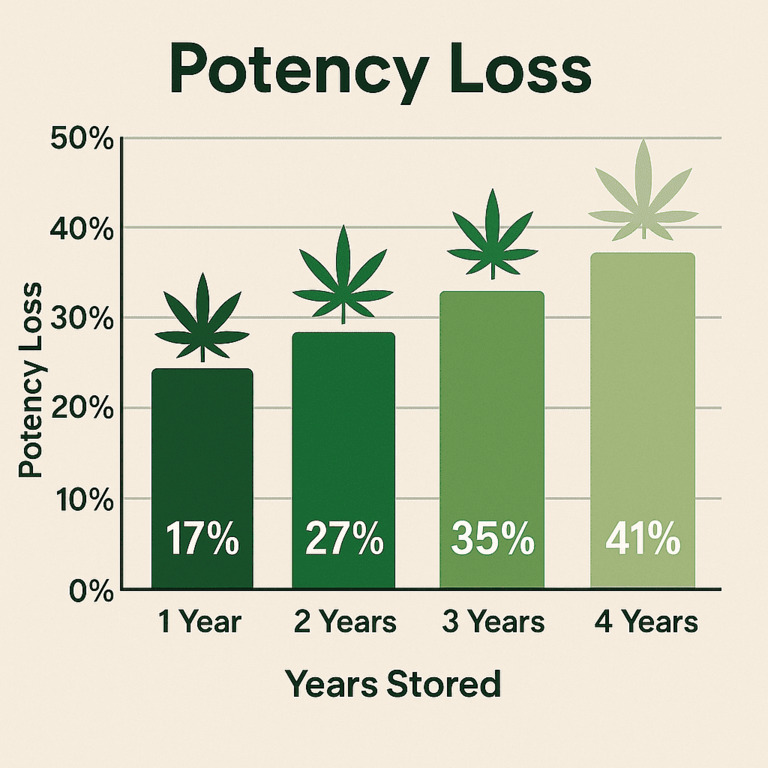
Cannabis potency declines primarily due to THC oxidizing into less potent CBN. Proper storage significantly reduces this loss. Below are average THC potency reductions over time at room temperature (20-22°C):
Sources:
https://www.healthline.com/health/does-weed-go-bad
https://cryocure.com/cannabis-shelf-life-what-keeps-marijuana-fresh/
Actual degradation rates depend on initial THC levels, strain genetics, and storage conditions. Optimal storage—airtight jars, stable humidity (59-63%), cool temperatures (60-70°F), and UV protection—helps preserve potency and extends shelf life.
Common Storage Mistakes to Avoid
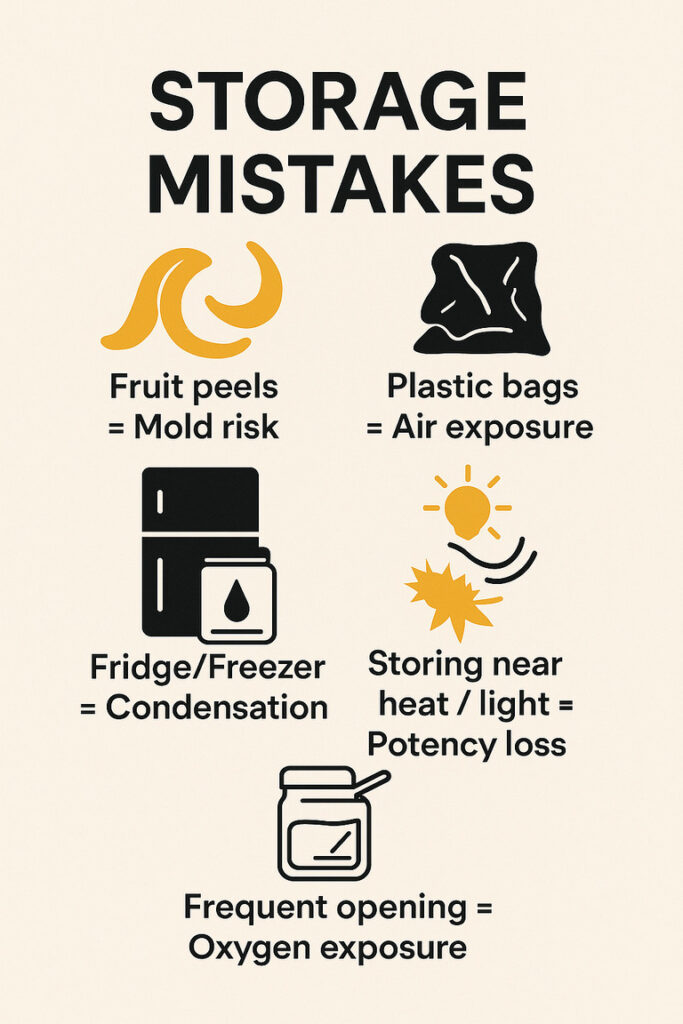
Preventing common mistakes in cannabis storage is crucial for maintaining its freshness, potency, and overall quality. Being aware of these pitfalls ensures your cannabis stays safe and effective for consumption:
Using Fruit Peels for Rehydration: Introducing fruit peels causes uncontrolled humidity, significantly increasing the risk of mold growth and promoting bacterial contamination.
Storing in Plastic Bags (e.g., Ziploc): Plastic bags are inadequate for cannabis storage as they allow moisture and oxygen exchange, air exposure, and static charges, which damage delicate trichomes and reduce potency.
Refrigerating or Freezing: These storage methods cause condensation inside containers, leading to moisture pockets and mold risk. Freezing specifically results in brittle trichomes, directly affecting cannabis potency, texture, and structural integrity.
Storing Near Heat or Light Sources: Exposure to heat or light sources rapidly accelerates the degradation of cannabinoids and terpenes, diminishing cannabis quality and potency.
Frequent Handling or Container Opening: Repeatedly opening containers or frequently handling cannabis exposes it to fluctuating humidity and increased oxygen contact, hastening cannabinoid oxidation, terpene loss, and overall degradation.
Avoiding these common storage mistakes significantly improves cannabis preservation, enhancing your cannabis experience by maintaining its freshness, potency, and therapeutic benefits.
When to Discard Weed
Discard Immediately If:
Visual signs of mold (fuzzy, web-like growth).
Musty or ammonia-like odor.
Consider Discarding If:
Buds are extremely dry, lack all aroma, or crumble into powder.
The smoking experience is intolerably harsh.
Cannabis freshness and potency depend on proper initial quality, genetic factors, and meticulous storage practices. Recognize degradation signs and adopt optimal storage strategies for the best cannabis experience.
For the ultimate experience, always choose fresh weed flower from a trusted dispensary to ensure top-tier flavor, aroma, and effects.
Maximize Freshness and Safety
Cannabis doesn’t go bad the same way food does, but it can lose its strength, smell, and taste over time. Things like too much light, air, moisture, or heat can slowly break it down and make it less enjoyable.
To keep your weed fresh and safe to use:
Use Airtight Containers and Keep It Dark: Store your cannabis in sealed glass jars or containers that block out air and light. This helps keep the THC and smell from fading.
Keep the Right Humidity: Cannabis likes to stay between 59% and 63% humidity. Humidity packs or special cannabis humidors help stop it from drying out or getting too wet.
Avoid Air Exposure: Too much air can make the active compounds lose their effect. Keep your stash sealed tight.
Check for Mold: Always take a look and a sniff before using. If it smells off or looks fuzzy, it’s best to toss it, especially if you have asthma or a weak immune system.
For the best quality, buy from licensed, reliable places like A21 Wellness Dispensary. They’re the go-to spot for top cannabis in Scotch Plains, NJ, and also serve Edison, Plainfield, Summit, and Westfield.
Need better ways to store your cannabis? Check out our 7ml Silicone Wax Container and our Green 4-Piece Aluminum Grinder — designed to keep your sessions smooth, efficient, and convenient.
Key Takeaways:
Weed doesn’t expire like food, but it does degrade over time — losing potency, aroma, and therapeutic effects.
Proper cannabis storage is essential: use airtight glass jars, keep temperatures cool (60–70°F), humidity stable (59–63%), and avoid exposure to light and air.
Plastic baggies, fruit peels, frequent opening, and fridge/freezer storage can cause mold, oxidation, or cannabinoid breakdown.
Moldy cannabis is unsafe to smoke and should be discarded immediately. Stale weed may be less effective but not dangerous if it’s clean and mold-free.
Weed pens, vape carts, THC oils, and edibles can all degrade or expire. Follow proper storage guidance and use them within 6–12 months for best quality.
THC gummies and other edibles expire like regular food—check the packaging, store them cool and dry, and avoid moisture.
Weed can stay good for up to 2 years if stored correctly; poorly stored weed can go stale or moldy in weeks.
Written by: A21 Wellness Dispensary Team
Certified Cannabis Professionals
At A21 Wellness Dispensary, our team comprises passionate cannabis experts, including THC-University certified staff members. With a deep understanding of cannabis cultivation, extraction, and consumption, we are dedicated to providing our customers with the knowledge they need to make informed choices. Our commitment to innovation and sustainability ensures that we offer a curated selection of premium cannabis products, meticulously cultivated and crafted to perfection.
Disclaimer
This article is for informational purposes only and does not constitute medical or legal advice. Always consult a healthcare professional before using cannabis products, especially if you have a medical condition, are taking medications, or live in a state with specific cannabis regulations.

